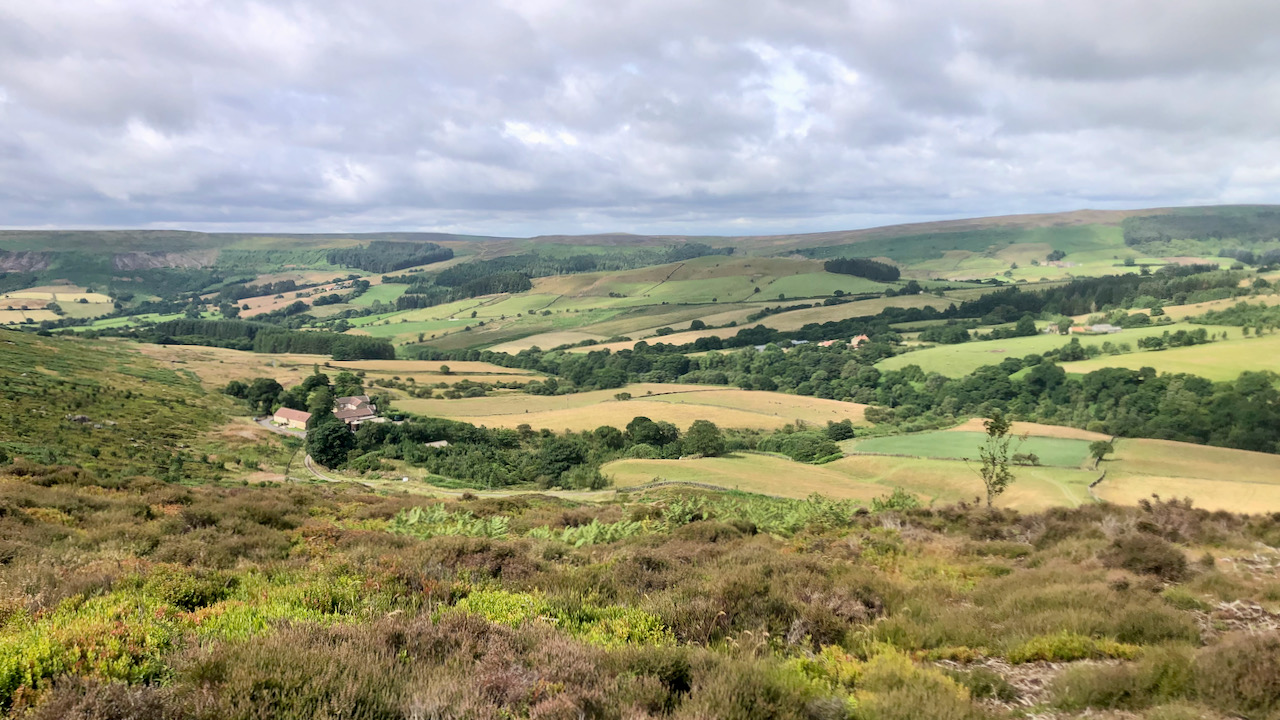More often than not, my decision regarding which photo to share is primarily based on the likelihood of returning to the same spot. Such was the case this morning.
Today’s image captures the western side of Cold Moor, offering a view down onto Cold Moor Cote in Raisdale. On the left, you’ll see this farm, which carries a name that fails to reflect its true Old English origins, for ‘cote‘ once referred to a humble hovel, hut, or small cottage1“North Yorkshire Littoral: Old Norse Place Names” URL: http://www.ramsdale.org/oldnorse.html.
During medieval times, Raisdale was divided into two manors: Magna and Parva Raysdale, meaning Great and Little Raisdale, respectively2“MEDIEVAL ASSARTING HAMLETS IN BILSDALE, NORTH-EAST YORKSHIRE.” JOHN McDONNELL. pp 271. These names, unfortunately, have not survived into the modern era. I surmise that this prong on the eastern side was known as Little Raisdale, while the slightly longer prong on the western side, beyond Wath Hill, was Great Raisdale.
Historical evidence indicates the presence of only one hamlet within Raisdale3“MEDIEVAL ASSARTING HAMLETS IN BILSDALE, NORTH-EAST YORKSHIRE.” JOHN McDONNELL. pp 277/8. Both prongs are situated along narrow and constrained ravines in their upper reaches, would not have offered suitable terrain for a settlement. However, further east, on a relatively level plateau sheltered by Cold Moor, a few fragments of written records are supported by findings of medieval pottery shards, suggesting the existence of a small cluster of dwellings. Cold Moor Cote, captured in the photo, was one of these hamlets. Little Raisdale, it seems, possessed a rudimentary manorial layout and structure. The name of Hall Garth Farm, concealed by the trees on the right side of the image, hints at a former manor house. Additionally, a town field, although now enclosed and converted into a meadow, persisted long enough to be documented on the 1782 estate plan to the west of the farm. Numerous well-defined shards, dating from medieval times and beyond, further substantiate this evidence. Furthermore, contemporary written records from the mid-13th century mention a chapel ‘at the exit of the vill‘ in Raisdale. Two charters from that era endowed ‘the chapel of Raisdale to support two chaplains there‘. It is likely that Little Raisdale did not survive long as a nucleated settlement. By the 17th century, it had dwindled to a group of three farms: Hall Garth, High Clay House, and Middle House. The latter ceased to exist by the 18th century.
At the turn of the 20th century, Hall Garth Farm was farmed by the Rev. J. L. Kyle, affectionately known as the “farming parson,” who was the vicar of Carlton-in-Cleveland4Blakeborough, J. Fairfax. “Life in a Yorkshire Village”. 1912.. In addition to his pastoral duties, the Reverend oversaw two farms, which he managed jointly. Cattle and sheep were brought down to his Carlton glebe for finishing, while horses were sent up to the higher pastures for summer grazing.
It always surprises me that behind every photograph lies a world of history waiting to be discovered.
- 1“North Yorkshire Littoral: Old Norse Place Names” URL: http://www.ramsdale.org/oldnorse.html
- 2“MEDIEVAL ASSARTING HAMLETS IN BILSDALE, NORTH-EAST YORKSHIRE.” JOHN McDONNELL. pp 271
- 3“MEDIEVAL ASSARTING HAMLETS IN BILSDALE, NORTH-EAST YORKSHIRE.” JOHN McDONNELL. pp 277/8
- 4Blakeborough, J. Fairfax. “Life in a Yorkshire Village”. 1912.

Leave a Reply